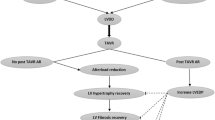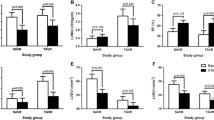Abstract
Background
Aortic stenosis is associated with concentric left ventricle (LV) hypertrophy or remodeling resulting in impaired diastolic function and elevated left-sided filling pressure. We investigated the changes in LV geometry and LV filling hemodynamics, giving emphasis to parameters associated with changes in diastolic function after transcatheter aortic valve implantation (TAVI).
Methods
Comprehensive diastolic assessment was performed before and six months after TAVI in 70 patients with severe aortic stenosis. Patients with any degree of mitral stenosis or >mild left-sided valvular regurgitation were excluded.
Results
In the entire cohort six months after TAVI, LV end-diastolic diameter increased (44.1 ± 6 versus 45 ± 6 mm, P = 0.02), whereas LV mass and relative wall thickness (RWT) decreased (270.1 ± 76 versus 245.1 ± 75 g and 0.53 ± 0.15 versus 0.46 ± 0.1, respectively; P < 0.0001 for both). Lateral e′ increased (5.8 ± 2 versus 6.6 ± 3 cm/s, P = 0.03) and left atrium (LA) volume, E/e′ ratio, and systolic pulmonary pressure decreased (88.1 ± 30 versus 80 ± 28 cc, 18 ± 7.8 versus 16.3 ± 5.5, and 42.7 ± 14.9 versus 38.7 ± 12 mmHg, respectively; P < 0.05 for all), suggesting reduction in LA pressure. The improvement in LA volume and E/e′ was almost exclusively seen in patients with LV hypertrophy before TAVI (P < 0.05 both), as opposed to patients with concentric remodeling.
Conclusions
In our preliminary study, TAVI resulted in LV and LA reverse remodeling, and improved LV relaxation and LA filling pressure in patients with severe aortic stenosis and concentric hypertrophy. Patients with concentric remodeling at baseline seem to have limited improvement in LV diastolic function and filling pressure following TAVI, but larger clinical trials would be required to conclude if they have no improvement at all.


Similar content being viewed by others

References
Carabello BA, Paulus WJ. Aortic stenosis. Lancet. 2009;373:956–66.
Holmes DR Jr, Mack MJ, Kaul S, et al. ACCF/AATS/SCAI/STS expert consensus document on transcatheter aortic valve replacement. J Am Coll Cardiol. 2012;59:1200–54.
Yarbrough WM, Mukherjee R, Ikonomidis JS, et al. Myocardial remodeling with aortic stenosis and after aortic valve replacement: mechanisms and future prognostic implications. J Thorac Cardiovasc Surg. 2012;143:656–64.
Devereux RB, Wachtell K, Gerdts E, et al. Prognostic significance of left ventricular mass change during treatment of hypertension. JAMA. 2004;292:2350–6.
Kupari M, Turto H, Lommi J. Left ventricular hypertrophy in aortic valve stenosis: preventive or promotive of systolic dysfunction and heart failure? Eur Heart J. 2005;26:1790–6.
Park SJ, Enriquez-Sarano M, Chang SA, et al. Hemodynamic patterns for symptomatic presentations of severe aortic stenosis. JACC Cardiovasc Imaging. 2013;6:137–46.
Vahanian A, Baumgartner H, Bax J, et al. Guidelines on the management of valvular heart disease: The Task Force on the Management of Valvular Heart Disease of the European Society of Cardiology. Eur Heart J. 2007;28:230–68.
Vizzardi E, D’Aloia A, Fiorina C, et al. Early regression of left ventricular mass associated with diastolic improvement after transcatheter aortic valve implantation. J Am Soc Echocardiogr. 2012;25:1091–8.
Lang RM, Bierig M, Devereux RB, et al. Recommendations for chamber quantification: a report from the American Society of Echocardiography’s Guidelines and Standards Committee and the Chamber Quantification Writing Group, developed in conjunction with the European Association of Echocardiography, a branch of the European Society of Cardiology. J Am Soc Echocardiogr. 2005;18:1440–63.
Nagueh SF, Appleton CP, Gillebert TC, et al. Recommendations for the evaluation of left ventricular diastolic function by echocardiography. Eur J Echocardiogr. 2009;10:165–93.
Park HS, Naik SD, Aronow WS, et al. Differences of lateral and septal mitral annulus velocity by tissue Doppler imaging in the evaluation of left ventricular diastolic function. Am J Cardiol. 2006;98:970–2.
Tzikas A, Geleijnse ML, Van Mieghem NM, et al. Left ventricular mass regression one year after transcatheter aortic valve implantation. Ann Thorac Surg. 2011;91:685–91.
Kurnik PB, Innerfield M, Wachspress JD, et al. Left ventricular mass regression after aortic valve replacement measured by ultrafast computed tomography. Am Heart J. 1990;120:919–27.
Eichinger WB, Botzenhardt F, Gunzinger R, et al. Left ventricular mass regression after aortic valve replacement with the mosaic bioprosthesis. J Heart Valve Dis. 2002;11:529–36 discussion 536.
Gelsomino S, Frassani R, Morocutti G, et al. Time course of left ventricular remodeling after stentless aortic valve replacement. Am Heart J. 2001;142:556–62.
Villari B, Vassalli G, Monrad ES, et al. Normalization of diastolic dysfunction in aortic stenosis late after valve replacement. Circulation. 1995;91:2353–8.
Sharma UC, Barenbrug P, Pokharel S, et al. Systematic review of the outcome of aortic valve replacement in patients with aortic stenosis. Ann Thorac Surg. 2004;78:90–5.
Monrad ES, Hess OM, Murakami T, et al. Time course of regression of left ventricular hypertrophy after aortic valve replacement. Circulation. 1988;77:1345–55.
Lessick J, Mutlak D, Markiewicz W, et al. Failure of left ventricular hypertrophy to regress after surgery for aortic valve stenosis. Echocardiography. 2002;19:359–66.
Giannini C, Petronio AS, Talini E, et al. Early and late improvement of global and regional left ventricular function after transcatheter aortic valve implantation in patients with severe aortic stenosis: an echocardiographic study. Am J Cardiovasc Dis. 2011;1:264–73.
Gotzmann M, Lindstaedt M, Bojara W, et al. Hemodynamic results and changes in myocardial function after transcatheter aortic valve implantation. Am Heart J. 2010;159:926–32.
Conflict of interest
Dr. Ariel Finkelstein receives consultation fees from Medtronic Cardiovascular and Edwards Lifesciences. All other authors declare no potential conflicts of interest.
Author information
Authors and Affiliations
Corresponding author
Additional information
K. Maayan and B. Simon contributed equally to the design and implementation of the study.
Rights and permissions
About this article
Cite this article
Maayan, K., Simon, B., Yan, T. et al. Predictors of improvement in diastolic function after transcatheter aortic valve implantation. J Echocardiogr 12, 17–23 (2014). https://doi.org/10.1007/s12574-013-0195-8
Received:
Revised:
Accepted:
Published:
Issue Date:
DOI: https://doi.org/10.1007/s12574-013-0195-8



